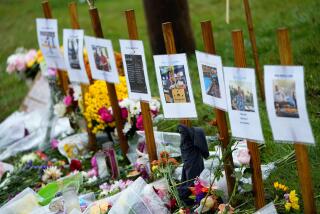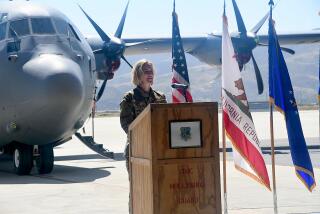Officer Was at Crossroads of Abu Ghraib Command
- Share via
FT. BRAGG, N.C. — As investigations into the abuse of prisoners at U.S. detention centers in Iraq and Afghanistan drag on, one indication of the ambiguity surrounding the issue is that an obscure captain in Army intelligence has become a potentially pivotal figure even though she’s not accused of wrongdoing.
The officer, Capt. Carolyn A. Wood, created a widely discussed PowerPoint chart at Iraq’s Abu Ghraib prison that spelled out what kinds of interrogation tactics were permitted under Army rules and what methods required special approval.
But what is expected to make Wood, 34, a crucial witness for investigators is that her unique assignment at the sprawling facility last year put her, in the words of one colleague, “at the narrow center of the hourglass, receiving information from above and from below” in the prison chain of command.
As a result, Wood may shed light on central questions in the wide-ranging inquiry: Did the decisions of senior commanders who wanted to increase the flow of intelligence from detainees play a role in the abuses? What interrogation techniques were approved? And who was responsible for ensuring that soldiers at military prisons followed the rules?
Last month, a report by the Army inspector-general documented almost 100 cases of detainee abuse and wrongful death in U.S. detention facilities but called them “aberrations” committed by a few inadequately supervised troops. The report was met with skepticism by senators who didn’t think it delved deeply enough.
Wood began her career as a 20-year-old private, had no direct role in interrogating detainees, according to friends and colleagues. But her administrative job as reports officer put her in a unique position to monitor and shepherd the transmission of intelligence at the interrogation center.
Sitting at a makeshift desk in a dilapidated building on the prison grounds, Wood was a conduit for day-to-day information collection, sending and receiving e-mail on a laptop computer. Friends and colleagues say she oversaw the production and distribution of intelligence reports from interrogations.
“She would disseminate information, taking it from lower levels and then sending it up the chain of command, and then back down,” said a friend of the captain’s who was familiar with prison operations.
Wood’s chart, which was posted inside the prison, listed approved interrogation techniques from an Army field manual in one column and more coercive methods requiring commanders’ approval in the second column. It became a sort of icon of the Abu Ghraib scandal.
The appearance of Wood’s chart, titled “Interrogation Rules of Engagement,” during a Senate hearing May 19 seemed to surprise Lt. Gen. Ricardo Sanchez, then the top U.S. commander in Iraq. He testified that he had never seen the chart, hadn’t approved it and had no idea who had created it.
Wood apparently prepared the chart on her own initiative in late summer 2003, when there were no clear written guidelines beyond the standard Army field manual. The Joint Interrogation and Debriefing Center at Abu Ghraib, where Wood was the reports officer in charge, was not formally established until Sept. 20.
The chart was posted in the interrogation center before Sanchez issued his first written regulations. Sanchez and other senior commanders have debated senators over whether Wood’s compilation was approved by superiors and whether it contradicted Sanchez’s rules.
There is no direct evidence that Wood, who left Iraq in February and was stationed at Ft. Bragg until May, was involved in or condoned abuses. In fact, her preparation of the chart suggests that she understood the disjointed state of command at Abu Ghraib, which Sanchez has called “dysfunctional.”
The prison had one military police officer for every 8 1/2 detainees, compared with one MP per two detainees at the U.S. military prison at Guantanamo Bay, Cuba.
Wood brought to Abu Ghraib a background as an intelligence officer at Bagram air base in Afghanistan, where interrogation techniques generally are harsher than those used in Iraq. That experience, coupled with her central role in Abu Ghraib and her training in “tactical exploitation” of intelligence, have made Wood an important source of information for investigators.
Friends and colleagues, who spoke on condition of anonymity because the Army has ordered soldiers not to discuss her, described Wood as an efficient workaholic who had a knack for organization and neatness.
“She’s the type of person who would take it upon herself to try to organize a confusing situation by putting together that chart the way she did,” a friend said.
An interrogator who worked with Wood in Afghanistan said she provided file boxes for her colleagues to reduce office clutter. “She was very organizational,” he said. “She got tired of people’s stuff all over the place.”
These colleagues said Wood would not have tolerated the abuses documented in photographs taken at Tier 1A of Abu Ghraib. One interrogator said she sometimes argued the cases of detainees at Bagram who were considered for transfer to Guantanamo, where conditions are more severe.
“I think she’s a quality person. Sharp. Just a straight-line officer,” he added. “I don’t think she would have approved of anything like [the abuse] unless somebody above her told her it was going to happen that way.”
That characterization is challenged by the reported allegations of a military lawyer for one of seven members of the 372nd Military Police Company facing criminal charges over events at Abu Ghraib.
At a hearing in Baghdad in April, the lawyer, Capt. Robert Shuck, said Wood was “involved in intensive interrogations of detainees, condoned some of the activities and stressed that that was standard procedure, what the accused [MP] was doing,” the Washington Post reported in May, quoting from a transcript of the proceeding.
In addition, investigators are conducting a criminal inquiry into the deaths of two detainees who were under the control of the unit Wood served with in Afghanistan in December 2002.
One friend of Wood’s said she had been questioned as part of the ongoing investigation headed by Lt. Gen. Anthony R. Jones, who was examining the role of military intelligence specialists at Abu Ghraib. The friend said Wood felt she was not sufficiently supported by commanders at the Senate hearings.
Army spokesmen at the Pentagon, at Ft. Bragg and in Baghdad have refused to provide details about Wood or her role at Abu Ghraib. They have not allowed her photograph to be released.
They said only that Wood had served as a military intelligence operations officer at the Bagram Collection Point in Afghanistan and was assigned to the 519th Military Intelligence Battalion at Abu Ghraib. Wood has declined interview requests.
She was transferred to the 519th from a military intelligence unit in Tikrit, in northern Iraq, because the 519th was understaffed, a friend said. She reported to Col. Thomas M. Pappas, commander of the 205th Military Intelligence Brigade. The head of the interrogation center, Lt. Col. Steven L. Jordan, also reported to Pappas.
Maj. Gen. Antonio M. Taguba, who conducted an earlier investigation of the prison, wrote that Pappas and Jordan were “directly or indirectly responsible” for detainee abuses because they failed to properly train or supervise soldiers under their command.
Taguba also cited abuses by members of the Joint Interrogation and Debriefing Center and the 205th brigade but did not name anyone pending the completion of Jones’ investigation into “the extent of culpability of MI personnel.” Wood was not mentioned among those interviewed by Taguba.
Wood’s position at the prison was elevated Nov. 19, when Sanchez gave Pappas and his military intelligence brigade “tactical control” of the prison for base protection and detainee security. A military police commander previously had been in charge of tactical control.
Col. Marc Warren, the top Army lawyer in Iraq, who said he had spoken to Wood, told a Senate hearing in May that Wood prepared the chart “with all good intentions” but because it displayed the logo of Sanchez’s command, it left the false impression that it had been approved by senior commanders.
Warren added that the chart “was intended to be a prophylaxis -- there’s really nothing insidious.”
Wood’s role at Abu Ghraib does not seem to have imperiled her Army career. She is a Bronze Star recipient who served in Bosnia and earned a college degree while in the service. She made the leap from enlisted person to officer by completing the Army’s demanding officer candidate school in 1999.
In May, Wood attended a captain’s course at the Command and General Staff College at Ft. Leavenworth, Kan., a base spokeswoman said. The course is required for promotion. Wood is currently training at the Army’s military intelligence school at Ft. Huachuca, Ariz., a base spokeswoman said.
At the Senate hearing, Sanchez was asked how a junior commander such as Wood could prepare such a specific list of regulations without consulting with senior commanders for approval.
“Sir, it’s difficult for me to understand it,” the general replied. “You’d have to ask the commander.”
More to Read
Sign up for Essential California
The most important California stories and recommendations in your inbox every morning.
You may occasionally receive promotional content from the Los Angeles Times.











